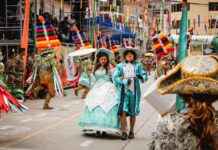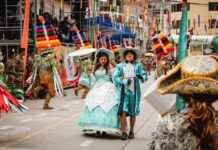A handful of associations have been working in this direction for more than ten years in France, like «La Possible Echappée», founded in 2007 in Paris by Kathy Mépuis, dancer, choreographer and teacher.
«The disability is there, we can’t deny it, but it is part of a difference that gives rise to another aesthetic. It is transcended by dance,» Ms. Mépuis told AFP.
– Towards the Paralympic Games –
With an educational department (500 dance and live performance workshops per year) and an artistic creation department (with about fifteen professional dancers), the association has evolved considerably.
Fifteen of its artists, including Gladys, will embark from October 24 on a creative project dedicated to the 2024 Paralympic Games ceremony, under the leadership of Robert Swinston, former dancer and assistant to the great American choreographer Merce Cunningham.
The company, which has eight creations to its credit, has also been working for months on two shows, «Esquisses» and «Passage», which will be presented in November in theaters in Ile-de-France.
«La Possible Echappée» is also associated with the Univi group (medico-social) around a study aimed at measuring the impact of dance on health through workshops in nursing homes.
«The word possible pleases me a lot because it allows us to go towards paths that we think are closed», assures Ms. Mépuis. «The breakaway evokes both a classical dance term (breakaway) and the breakaway as a breath of fresh air».
The artist prefers to avoid the terms «inclusive dance» or «adapted», just like Gladys Foggea. «It moves differently but we find the same freedom as an able-bodied person», explains the Guadeloupean dancer.
Today she fully lives her passion, notably with «Passage», where she performs a duet with a dancer from the Paris Opera, Maxime Thomas.
«He didn’t know about the disability, I had never worked with dancers from the Opera, and surprisingly, we matched,» she smiles.
During rehearsals at the Center Maurice Ravel (12th arrondissement of Paris), the dancer lets himself be carried by her and by the wheelchair which she spins, or leans against it to perform an arabesque.
Gladys also dances an amazing tango with Sabrina Roger, also in a wheelchair.
«You have to combine the movements of the chair and the arms, that’s what will make the beauty of the movements», affirms the artist, who had been hit by a car and who thought her dream of a dancer was shattered forever.
More than an object to move around, the wheelchair is an integral part of creation.
«Often, when you are paraplegic, you have the feeling of being cut in half. Dancing really allowed me to reattach the legs with the trunk and to reconcile myself with this body», she adds.
– «Playing with inertia» –
Sabrina Roger wants people to come «not to see people in wheelchairs but to see a show». She remembers being hired once on video by someone who thought the chair was an artistic prop.
Affected by a genetic disease causing her coordination disorders, the artist, trained in classical dance, can hold moments on her legs, which still opens up possibilities of alternating standing and sitting positions.
«The day I lost my balance (…), I started to dance with the imbalance, to play with the inertia», she recalls, hoping to collaborate with other choreographers.
Maxime Thomas says he saw his creativity «stimulated» by the mere fact of looking for different solutions. And to note that there are in the end «a lot of common points».















